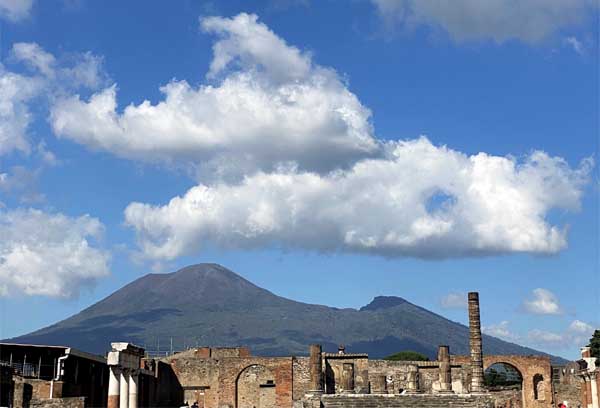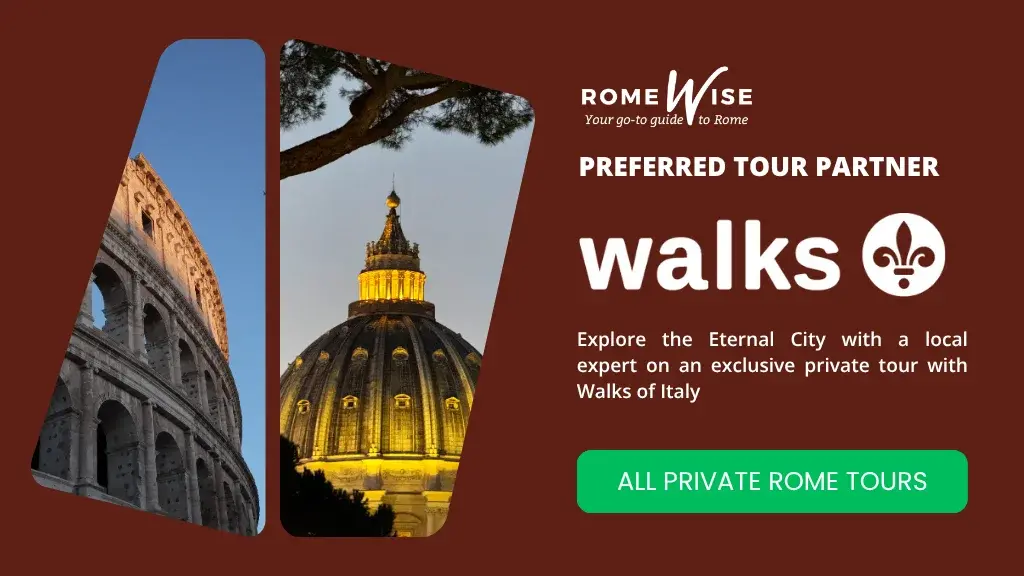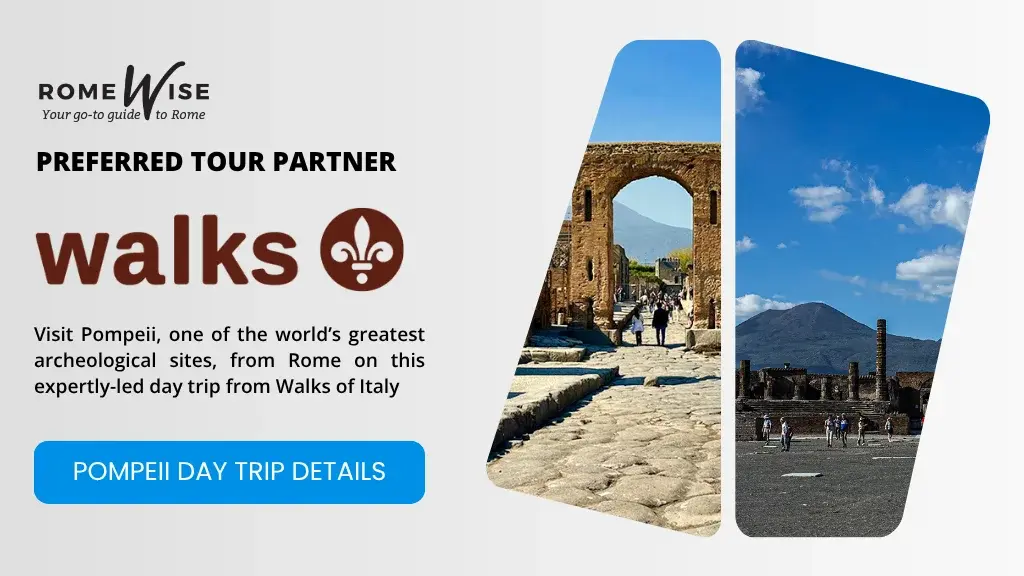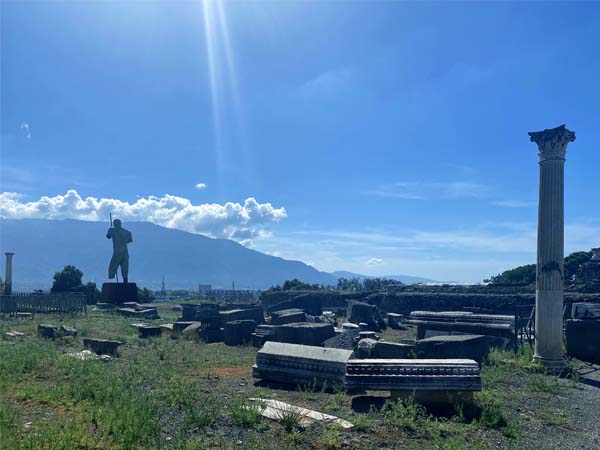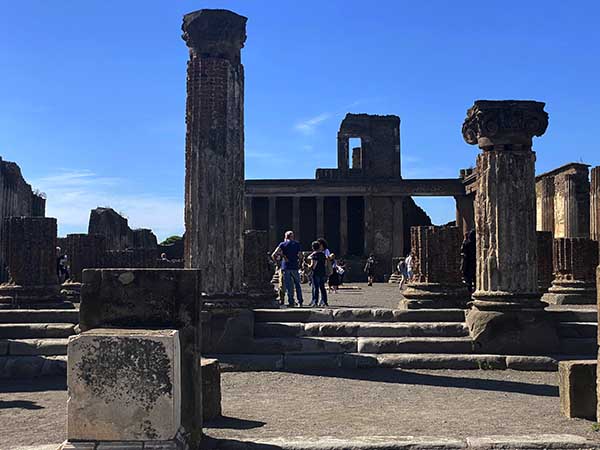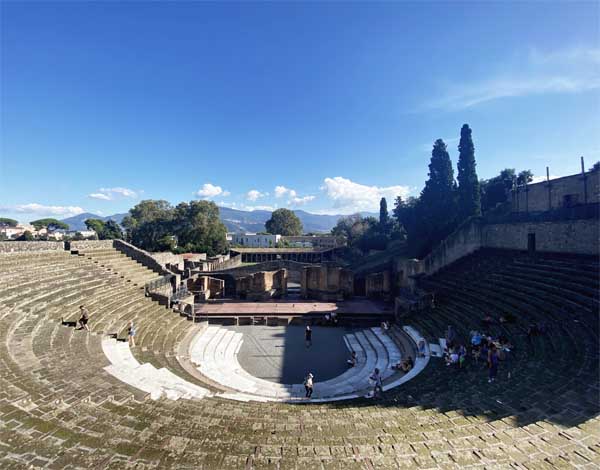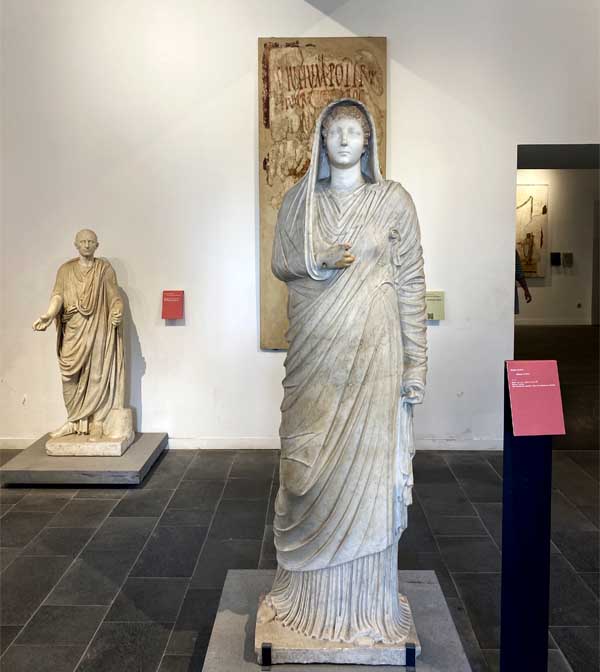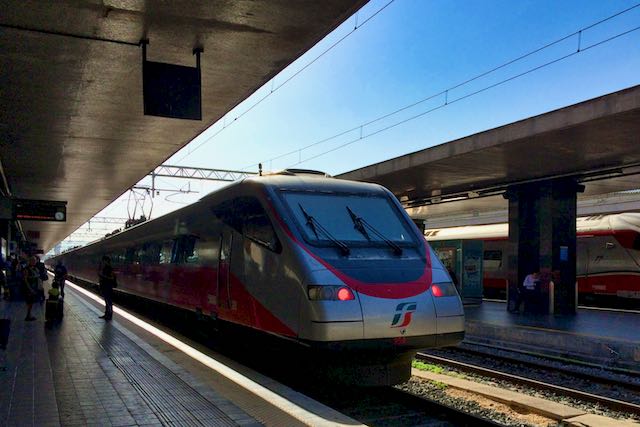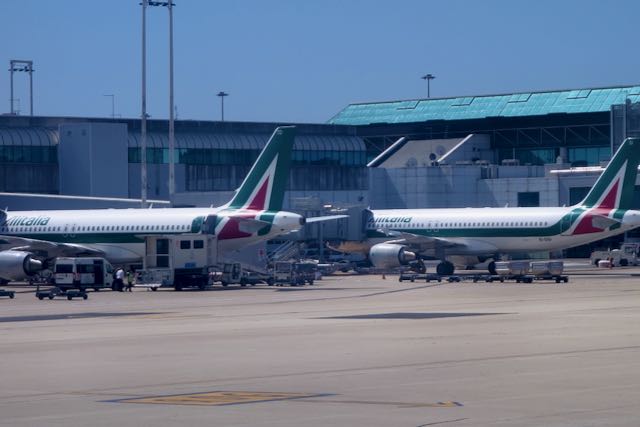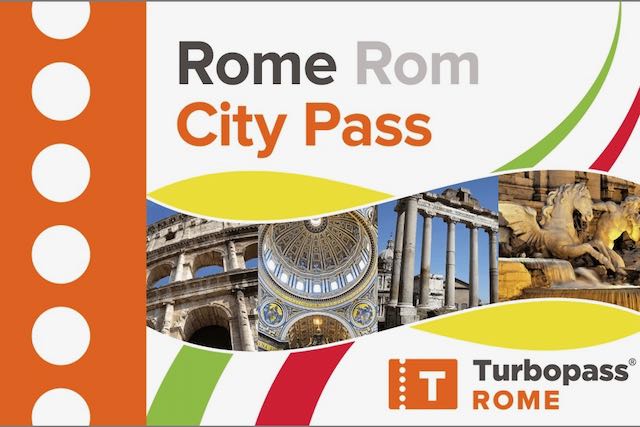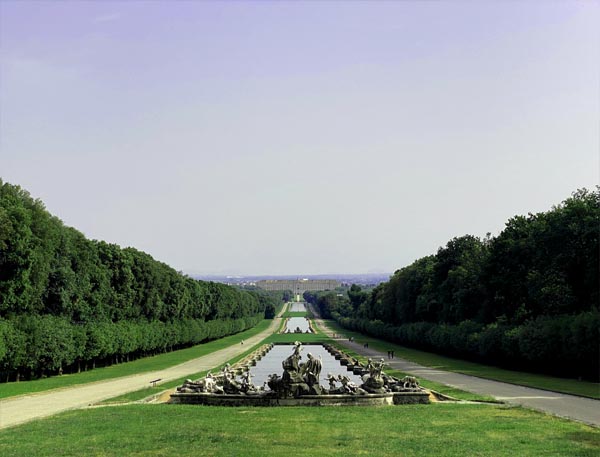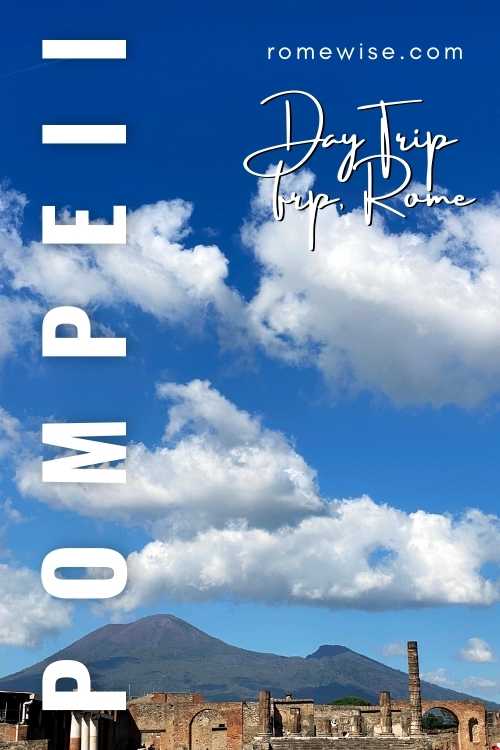- Sign up & get a FREE ebook Subscribe NOW!
- Romewise Home Page
- Pompeii from Rome
Pompeii from Rome Day Trip
Looking to visit Pompeii from Rome?
Pompeii has to be one of the most famous ancient Roman archeological sites – its incredible legacy in understanding the lives of ancient Romans is unrivalled, and the story of its destruction rings throughout history.
Pompeii from Rome - the best tips for what to see and do
Find out the best ways to visit this world-renowned UNESCO World Heritage Site.
On this page we'll cover:
- What is Pompeii?
- Is a Pompeii day trip worth it?
- A (Brief) History of Pompeii
- Where is Pompeii in relation to Rome?
- How to get from Rome to Pompeii
- How accessible is Pompeii?
- Is it possible to see the Pompeii ruins for free?
- When is the best time to visit Pompeii?
- Pompeii ticket prices and tours - all options
- Pompeii trip must-sees
- Other things to see near Pompeii
- Where to eat and drink in Pompeii
What is Pompeii?
There are two answers to this question.
The first is that it refers to the modern town, located 23km from the center of Naples.
The modern town of Pompei is adjacent to the original settlement of Pompeii - an ancient Roman city frozen in time by the eruption of Mount Vesuvius in 79 CE, and it is how you can visit Pompeii from Rome that is the focus of this page.
Is a Pompeii day trip worth it?
Pompeii is a must-visit for anyone interested in ancient Roman history or the history of Rome, where few other sites have contributed so much to the understanding of the daily lives of the ancient Romans.
Pompeii was buried during the volcanic eruption of Mount Vesuvius in 79 CE and as such became a huge time capsule, capturing a moment nearly 2000 years ago and preserving it forever.
Following its discovery in the late 16th century, Pompeii has slowly given up its secrets as archeologists have unearthed huge sections of the ancient city under layers of volcanic ash.
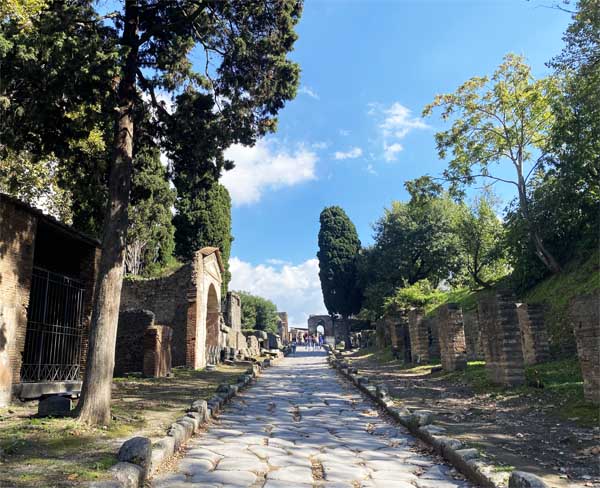 Follow in the footsteps of the ancient citizens of Pompeii, literally as you walk the same roads as them.
Follow in the footsteps of the ancient citizens of Pompeii, literally as you walk the same roads as them.Jump start your trip to Rome with a free ebook 😀
Sign-up to our free newsletter and receive our Quick Start Guide to Rome ebook which share's everything you need to know to plan the perfect trip to the Eternal City 🙌
A (Brief) History of Pompeii
Archaeological evidence suggests that people first settled in the area of Pompeii in the eighth century BCE.
Within a couple of hundred years the town began to take shape, with temples and other important buildings (some of which are still visible today) were constructed.
In the following centuries, Pompeii's fortunes fluctuated, until it came under direct rule from Rome.
Pompeii formally became a colony of Rome in 80 BCE where over the following decades substantial building projects were undertaken the city expanded greatly.
In 62 CE a strong earthquake destroyed large parts of the city - these were quickly rebuilt and more construction ordered, making Pompeii one of the area's major cities.
Only 17 years later, in 79 CE, Mount Vesuvius erupted in what is one of the most infamous volcanic eruptions in history.
Over the course of the next few days, ash and pumice rained down on Pompeii and the surrounding area, completely burying the town.
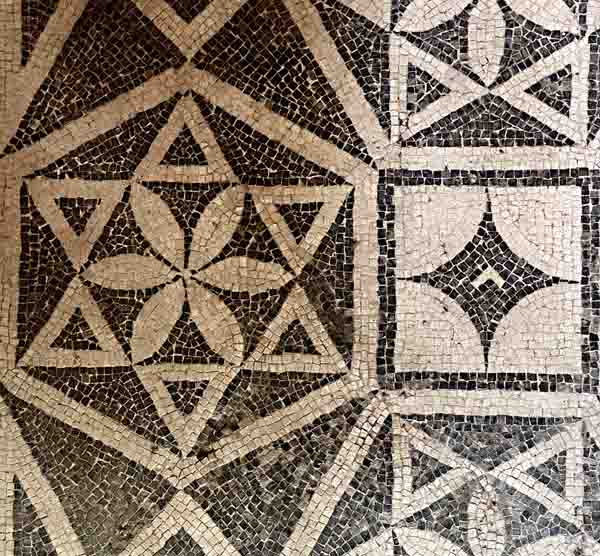 Everywhere you look in Pompeii you'll spot beautiful mosaics, frescoes and other decorative elements, perfectly preserved by the volcanic debris from the eruption in 79 CE.
Everywhere you look in Pompeii you'll spot beautiful mosaics, frescoes and other decorative elements, perfectly preserved by the volcanic debris from the eruption in 79 CE.Over the ensuing centuries people continued to live in the area of Pompeii but the town did not return to its pre-eruption eminence.
The modern town of Pompei is now home to around 25,000 people and is a key part of the extra-urban area outside of Naples with connections available to other notable areas such as the Sorrentine Peninsula and Amalfi Coast.
Where is Pompeii in relation to Rome?
Pompeii is located 210km/130 miles south of Rome, in the region of Campania.
How to get from Rome to Pompeii
Traveling from Rome to Pompeii is very straightforward – I can recommend three options for transportation from Rome to Pompeii:
By High Speed Train (and a local line):
To travel from Rome to Pompeii by high speed train, your departure point should be Rome’s Termini (Roma Termini) station.
You can book a ticket direct to Pompeii station on a high speed train. This is to the station for the modern town, which is around a 20 minute walk to an entrance of the archeological site.
Book online via Trainline to see all routes, prices and keep track of your tickets while on the move.
Alternatively you can do a route that gets you closer to the archeological site.
First, travel from Rome to Naples Centrale by high speed train, your departure point should be Rome’s Termini (Roma Termini) station.
To maximize your time at Pompeii, consider departing Roma Termini station around 8:00.
These high speed trains run multiple times per hour, and ticket prices average 40€ per person for a standard single direction ticket
Consider paying a little more (typically 10€-15€ per journey) to upgrade to a Prima coach - this is for first class passengers and guarantees access to power outlets plus other extras such as a free drink (typically a choice of water, juice or coffee - no alcohol, sorry!).
Once you arrive at Naples Centrale (journey time typically between 1 hour and 1 hour 15 minutes), follow the signs for the ‘Circumvesuviana’ train line (sometimes labelled as 'Linee Vesuviane').
This is the line that circumvents Vesuvius, going to multiple destinations – hence the name!
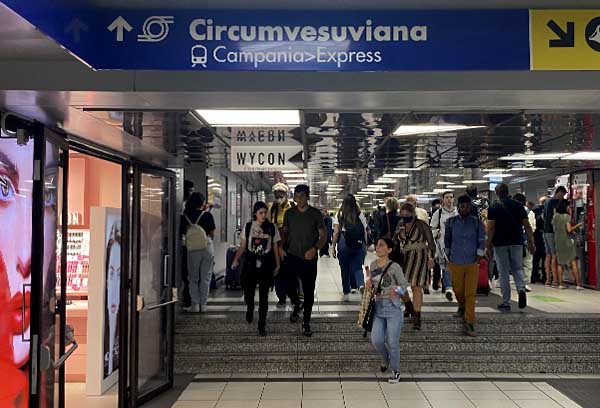 The line you need is well sign posted throughout Napoli Centrale after getting off the high speed trains from Rome.
The line you need is well sign posted throughout Napoli Centrale after getting off the high speed trains from Rome.Request a ticket from the counter for Pompeii Scavi and follow the directions to the train platform.
These ticket prices are fixed and it's not possible to book online.
I would recommend using a card when purchasing to reduce the cash you are carrying while on the move.
The trains run multiple times per hour and the journey from Naples takes just over a half hour.
Sadly this is not a high speed train - take the time to prep for your visit to Pompeii's ancient ruins.
Once you arrive at Pompeii Scavi train station, simply follow the signs for the archeological park.
The Porta Marina main entrance is less than two minutes walk.
Note for some guided tours/tour guides the meeting point is often the Pompeii Scavi station.
A NOTE ABOUT THESE LOCAL TRAINS!
There is also a train line called the 'Campania Express' that runs between Naples and Pompeii.
These trains are less frequent than the normal line and are more expensive, but take a little less time.
Pay close attention to the timetables and plan accordingly!
Driving from Rome to Pompeii
Click here to view all parking options near Pompeii - they are all pretty similar in terms of value and service.
Select your preference using Google Maps and set off – a direct drive from Rome will take between 3 and 4 hours, depending on where you start from and allowing for rest stops.
DRIVING IN ITALY - BE PREPARED!
The freeways/motorways in Italy (autostrade) are mostly subject to tolls, and you should budget an average of 1€ per 10km traveled.
These tolls are paid at the toll booths (alt stazione).
CAUTION!
Be sure to select the correct lane based on your preferred payment method, and avoid the yellow TELEPASS lanes – these are only for pass holders and using them unauthorized will result in a heavy fine when you come to the next toll booth.
With a tour guide or private transfer
Guides/drivers can often offer the option of a hotel pickup and then take you directly to the Pompeii site, in an air conditioned coach with a bus driver and passionate guides.
AN EASY ALTERNATIVE TO POMPEII!
Unable to get to from Rome to Pompeii?
Consider visiting Ostia Antica, much closer to central Rome and reachable by train from the Piramide metro station in less than 40 minutes.
Like Pompeii, you’ll find a sprawling archeological park featuring dozens of historically significant ancient Roman monuments.
To find out more about visiting Ostia Antica, visit our dedicated page here.
How accessible is Pompeii?
While efforts have been made to make Pompeii more accessible, visitors with mobility challenges may face difficulties both arriving at Pompeii from Rome, and then getting around the site.
Access to the train platforms for the Circumvesuviana Line at Napoli Centrale is only via stairs or escalators.
There are no lifts or other mobility assistance to get down to the platforms.
Consider arranging a private transfer or taxi from the high speed train station to Pompeii, or even for the whole journey from Rome to Pompeii.
The driving distance from Rome to Pompeii is not so far as to make it impossible for a day trip!
Access via the main Porta Marina entrance is not viable for anyone with mobility challenges due to uneven surfaces, steps and steep ramps.
The park does have an itinerary for people with motor disabilities, called 'Pompeii for All'.
The accessible entrance is at Piazza Anfiteatro, and the route runs for 3.5km/2.2 miles.
For more details refer here to the official Pompeii website.
If in doubt, consider booking a private tour with an operator who is experienced in taking visitors to Pompeii with mobility challenges.
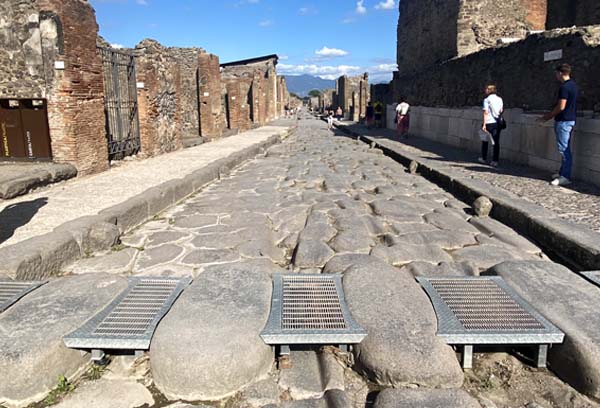 Provisions such as metal plating between the road stepping stones are present through Pompeii to aid navigation.
Provisions such as metal plating between the road stepping stones are present through Pompeii to aid navigation.Is it possible to see the Pompeii ruins for free?
On the first Sunday of every month entrance to Pompeii is free to anyone and everyone - part of the same scheme that grants access to a lot of free sites in Rome.
Book ahead if you plan to visit Pompeii on a free Sunday and arrive as early as possible.
It will be extremely busy.
In the event more than 15,000 people are in the park by midday, the entrances will be closed for an hour to allow existing visitors to leave.
You cannot book skip the line tickets for the Free Sundays.
Certain groups may be eligible for free (or heavily discounted) entry to Pompeii - to find out more, visit the official website here.
When is the best time to visit Pompeii?
Pompeii is open year round, and only closed on January 1, May 1 and December 25.
The Pompeii opening times and hours of operation vary according to the time of year, before making the day trip from Rome to Pompeii, be sure to check the official website.
Personally I’d recommend visiting in late May/early June or September-October if possible.
You should (no promises!) find the weather dry and warm, but not too hot!
Visiting Pompeii in fall and winter
During the cooler months, the weather in this part of Italy can be temperamental.
While clear and dry most of the time, powerful storms can form making conditions for walking around an archeological park less than desirable!
If you can only visit at this point, be sure to wear a waterproof jacket and bring a decent umbrella, just in case!
Visiting Pompeii in spring and summer
During the peak season summer months, the exposed nature of the site combined with Pompeii’s proximity to a major city (Naples), means temperatures can often be close to 100F, if not higher.
If visiting at this time of year, be sure to bring a hat, plenty of water and sunblock.
Disclosure: If you make a purchase through a link on this page, I may receive a small commission - at no extra cost to you. Thank you for supporting my site!
Pompeii Tickets and Tours - All Options
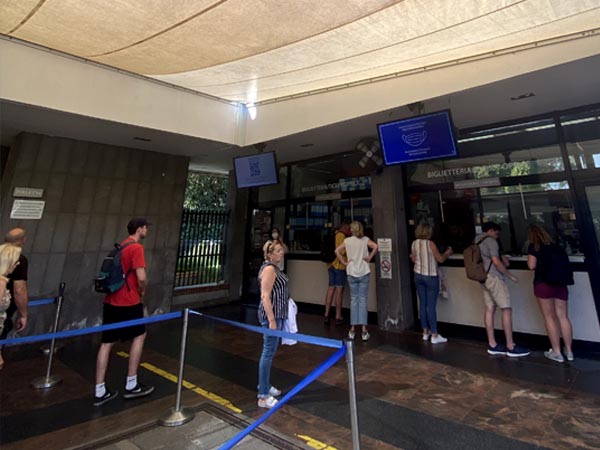 You can buy tickets also at the ticket counter at Pompeii, but I don't recommend this - book online in advance to save yourself time!
You can buy tickets also at the ticket counter at Pompeii, but I don't recommend this - book online in advance to save yourself time!For self-guided visits, the base entrance fee to Pompeii is currently 18€, but there are different ticket combinations available.
Check the official website for all the different options!
Note that the standard tickets are not skip the line tickets, and it is not possible to book these directly.
Overwhelmed by the number of Pompeii tours on offer?
Our trusted partner Walks of Italy have very high ratings and pride themselves on giving everyone a fantastic experience.
Disclosure: If you make a purchase through a link on this page, I may receive a small commission - at no extra cost to you. Thank you for supporting my site!
Pompeii Tours
Browsing Rome day trips to Pompeii gives you lots of options, but to maximize your day trip from Rome to Pompeii, consider booking a guided group tour, and if possible, with a local guide.
Locals often know things that non-locals don't, providing a richer experience and smaller groups enable you to ask questions and make the most of your visit.
Private tours often offer full transport/transfer options to make your day tour stress-free.
Pompeii must-sees
Pompeii is vast; when Vesuvius erupted, it is estimated the ancient town had a population of 12,000 with the same amount of people also living on the outskirts - comparable to the population of modern Pompei.
Current estimates put the percentage of excavated ground at just over two-thirds, meaning that there is still a huge part to unearth.
You could easily take a full day to see the majority of the site.
If you are very interested in ancient Roman history, consider staying a night in the area so you can split your trip from Rome to Pompeii across two days!
If you are time-limited, here are a series of absolute-must sees, which if followed in order (on the basis you enter the park from the entrance near the Pompeii Scavi train station) will take you past a lot of other notable monuments as you explore the ancient cobbled streets.
TOP TIP!
When you first arrive, be sure to look for the TV screens at the entrance where you can purchase tickets, which will advise which villas and other special locations are open that day.
The hours of these sites are sometimes restricted so if you want to visit be sure to pay close attention to the schedule!
Porta Marina & Cinta Muraria
On arrival, you'll enter the site via one of the city's original gates - this gate was the most impressive, and is called the 'Marine Gate' because it originally faced the sea and shoreline.
If you have free time, before heading through the gate, bear left and explore the bath complex here - it serves as a great introduction to the site!
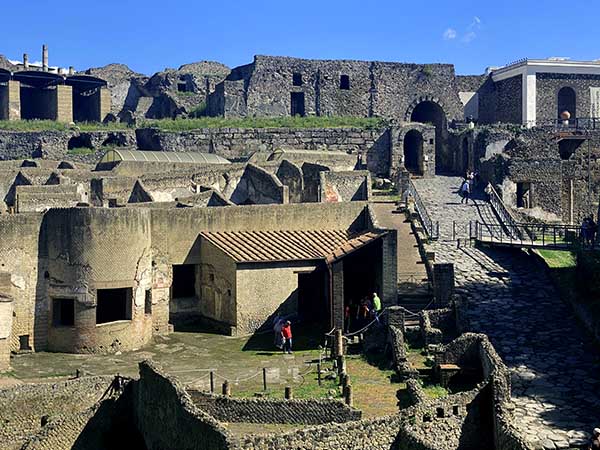 Take in the view when you first arrive from Rome to Pompeii - from the entrance you can see the layers of history
Take in the view when you first arrive from Rome to Pompeii - from the entrance you can see the layers of historyForum
After walking up the slope from the entrance, continue straight and you'll find yourself in the Forum of Pompeii.
Like the Roman Forum in Rome, this space was the focal point of life in the ancient city.
Business was conducted here, social gatherings took place, religious ceremonies undertaken and much more.
From the Forum you can visit several of Pompeii's most impressive monuments, including the Basilica, the Temple of Jupiter and the Temple of Apollo.
Villa dei Misteri (Villa of the Mysteries)
Before exploring the town of Pompeii, I'd recommend taking a slight detour to the scavi Villa dei Misteri (excavations of the Villa of the Mysteries) located approx. 15 minutes walk from the Forum.
Following the suggested route (signposted) you'll pass a set of bathrooms - use this opportunity to refresh yourself.
As you follow the ancient streets you'll pass countless ancient homes and businesses, before exiting the city limits where you'll then find the road lined with tombs.
In ancient Rome it was customary to bury the dead outside of the city.
When you arrive at the scavi Villa dei Misteri, you'll find yourself transported back in time; this is one of the best preserved ancient Roman villas anywhere, let alone in Pompeii.
Marvel at the original decorative flooring and recently restored frescoes and immerse yourself in the peace and tranquility of the surroundings.
In ancient Rome times, this would have felt like a haven away from the hustle and bustle of Pompeii!
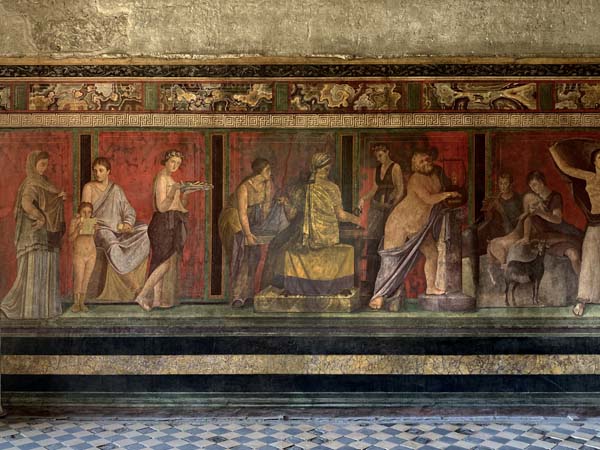 The name of this villa comes from the fact that experts can't agree on the story being told in this famous fresco - while plenty of theories exist, not one has been definitively chosen so it (currently) remains a mystery!
The name of this villa comes from the fact that experts can't agree on the story being told in this famous fresco - while plenty of theories exist, not one has been definitively chosen so it (currently) remains a mystery!Region V
When you leave the scavi Villa dei Misteri, take the same road back to the main part of the old town before following the signs for 'Regio V' (Region 5) - this is one of the 'newer' sections of Pompeii, in that much of it has been excavated only relatively recently.
As such, not all areas are open all the time, but if you can, be sure to visit the:
- Thermopolium - recent restoration work has brought this ancient Rome bar back to life where you can now see the frescoes that showed patrons what was on offer, not unlike a modern bar.
- House of Orion - also recently revealed and restored, this house features unique frescoes and mosaics, unseen elsewhere in Pompeii or the surviving ancient Roman world.
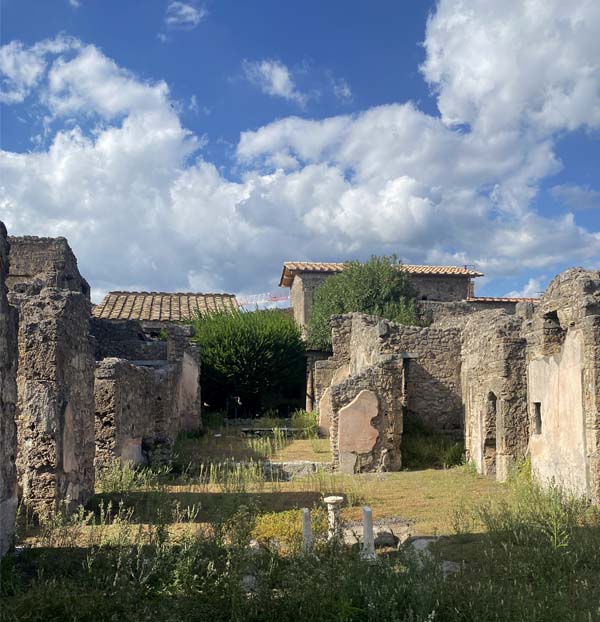 Even if you can't access the sites in Region V, take a walk through the ancient Rome streets here - not many visitors venture this far, and you'll discover quiet spaces to enjoy.
Even if you can't access the sites in Region V, take a walk through the ancient Rome streets here - not many visitors venture this far, and you'll discover quiet spaces to enjoy.Theater District (Region VIII)
After the Forum, this district would have been the most lively during ancient times.
It houses two theaters, the gladiator barracks and several other important structures including the incredibly well-preserved Temple of Isis.
If time allows, enter the main theater and take a seat on the stone benches.
Imagine watching a play here, and consider for a moment you are sitting in the exact same spot that the ancient citizens of Pompeii sat nearly 2000 years ago!
Amphitheater District (Region II)
In this district, at the edges of the visitable park, you can visit the ancient city's amphitheater and the adjacent Palestra.
Gladiatorial games and other public events were held here on a regular basis, and the size of this district is a testament to Pompeii's prominence in the area.
From here you can choose to exit the park (if you're on a self-guided visit) via Piazza Immacolata and take the short walk back to the Pompeii Scavi train station.
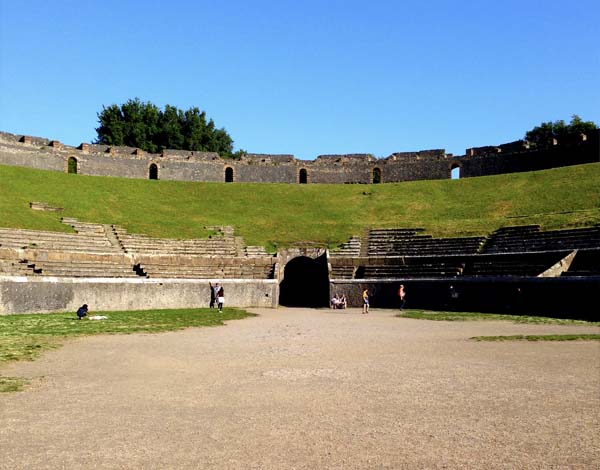 This is the oldest still-standing example of a permanent stone amphitheater from the Roman world, and served as inspiration for later amphitheaters including the Colosseum in Rome.
This is the oldest still-standing example of a permanent stone amphitheater from the Roman world, and served as inspiration for later amphitheaters including the Colosseum in Rome.Antiquarium (Museum)
If you have not left Pompeii after seeing the amphitheater, return to the Forum and follow the signs for the exit.
This will take you past the Temple of Venus and you'll see steps down to the Antiquarium (museum).
This is one of the newest additions to the park and houses artefacts found in Pompeii plus two small book/gift shops - visit if you have time as the collection has been curated thoughtfully and helps to round-off any visit.
Other things to see near Pompeii
Outside of Rome, the area surrounding Pompeii features one of the highest concentrations of ancient Roman sites anywhere.
If you find yourself with free time or are wanting to explore further on your day trip from Rome to Pompeii, ancient Roman history lovers should consider visiting:
- Herculaneum – like Pompeii, this town was destroyed in the eruption of Vesuvius in 79 AD and while smaller in scale, certain elements are even better preserved than at Pompeii. You can take a guided tour which takes you from Rome to Pompeii and then Herculaneum on your trip.
- Villas of Castellamare di Stabia (Ariana & San Marco), Oplontis and Boscoreale – these four ancient homes offer an insight into how the people of this area lived and worked 2000 years ago, from winemakers through to members of the imperial family.
- Capua - this now humble town was once ancient Rome's regional capital of this area (before Naples came to prominence), connected directly to Rome via the famous Via Appia. It was here that Spartacus started his infamous revolt – you can even visit where he trained as a gladiator!
- Phlegraean Fields (Campi Flegrei) – this vast zone just outside of Naples is home to several important sites including Pozzuoli (featuring a well-preserved amphitheater), Baiae (once the Las Vegas of ancient Rome) and Cumae (where an Oracle resided).
- Sorrento – famous now as the birthplace of limoncello, Sorrento was originally an ancient Roman settlement featuring a palace owned by the son of Agrippa, the right-hand man of emperor Augustus.
- Capri island – here Rome’s second emperor, Tiberius, had his summer palace – Villa Jovis. Situated on one of the island's highest points, you’ll struggle to find a better view of the Bay of Naples.
- Positano – situated under the town’s main church (Chiesa di Santa Maria Assunta) you’ll find one of the best-preserved ancient Roman villas in existence.
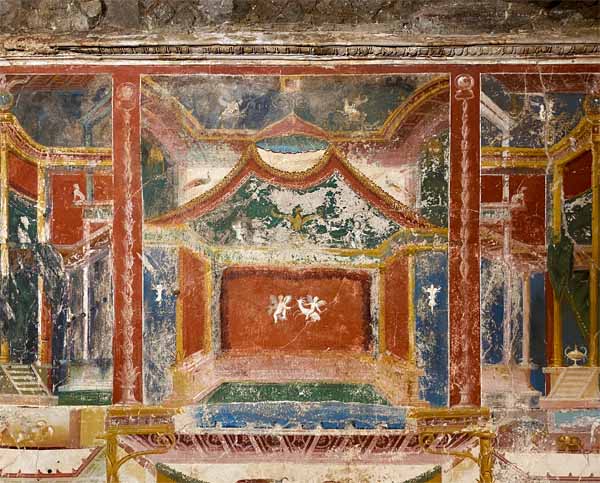 Like Pompeii and Herclaneum, this villa in Postiano was buried by volcanic debris from the eruption of Vesuvius in 79 AD, preserving its frescoes perfectly in time.
Like Pompeii and Herclaneum, this villa in Postiano was buried by volcanic debris from the eruption of Vesuvius in 79 AD, preserving its frescoes perfectly in time.Moving beyond ancient Rome, there is no shortage of other things to do and places to visit near Pompeii:
- Naples – As the regional capital of Campania and a major Italian city since the middle ages, Naples is a history and culture hub. Naples is also famous for its cuisine – it was here that the pizza was invented after all! If you want to really explore Campania, Naples is a great base - staying in an apartment gives you maximum flexibility for your travels!
- Caserta – The Royal Palace of Caserta was the largest royal residence in Italy, and one of the biggest in Europe. Modeled on Versailles Palace outside of Paris, it was here that the kings of the Two Sicilys, and for a brief period, the King of Italy displayed their wealth and power.
- Ischia – Famous for its natural springs, if you are looking for a peaceful break in paradise-like settings, book a ferry from Naples and head to the island of Ischia for a magical day trip!
- Procida – The smallest of the islands in the Bay of Naples, Procida was selected as the 2022 European Capital of Culture and you’ll struggle to find anywhere more picture-perfect in the world.
- The Amalfi Coast – world-renowned for timeless views and picturesque cliff-side towns, this slice of heaven is within easy reach of Pompeii.
Where to eat and drink in Pompeii
Inside Pompeii site you'll find a cafe/bistro (with air conditioning - a blessing if visiting in the summer!) but this can get very busy.
As such, I'd recommend bringing your own lunch/snacks and drinks for while you are in the archaeological park.
If you are taking the high speed train from Rome, you'll find plenty of great options in Naples Centrale station in the 'Foodcourt' which you can grab when changing lines.
Immediately outside the entrances to Pompeii are several bars - the food at these places is not the best (but will do if you're in a pinch) but they are useful for grabbing something to drink on your way in or out of the park.
 If you find yourself with time at Napoli Centrale train station, head to the foodcourt and grab yourself an authentic Neapolitan sfogliatella - the two traditional versions come in either shortcrust pastry, or filo/flaky pastry, but both are filled with sweet ricotta and candied fruits.
If you find yourself with time at Napoli Centrale train station, head to the foodcourt and grab yourself an authentic Neapolitan sfogliatella - the two traditional versions come in either shortcrust pastry, or filo/flaky pastry, but both are filled with sweet ricotta and candied fruits.Romewise's Top Travel Resources
Ready to book your trip to Rome? Take a look at these helpful links to companies we use and trust:
- Keep your travel spending simple with the Wise card, which removes all the worry about exchange rates and high transaction fees all over the world
- Search for and book your perfect accommodation
- Our complete guide to what to pack for Rome
- The number one travel accessory, a multi-point travel adapter and voltage converter
- Browse a huge range of tours in Rome and beyond
- Experience unique tours and special access to Rome's most popular sights
- Protect yourself with comprehensive travel insurance
Within this post there are some affiliate links for products and services. For more details about our affiliate policy click here.
Get your 100% free Rome trip planner now!
Simply sign-up today for our free newsletter and get the Romewise Quick Start guide to Rome:
We are committed to respecting your data. Click for our Privacy Policy.
Comments? Questions? Suggestions?
Please come over to the private Romewise Facebook group and join in the conversation.
You will often find me there, happy to answer your questions / comments!
You will also meet other Rome lovers and experts, too.
What are you waiting for?
- Romewise Home Page
- Pompeii from Rome

